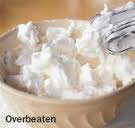6 Secrets to Successful Egg White Whipping
By Alice Osborne
 Summer and lemon meringue pie - they go together like peanut butter and jelly, salt and pepper, Laurel and Hardy... you have the picture.
Summer and lemon meringue pie - they go together like peanut butter and jelly, salt and pepper, Laurel and Hardy... you have the picture.
But a lot of folks avoid making lemon meringue pie because they aren't that comfortable whipping egg whites. I know, they've been telling me. So how about uncovering the secrets to successful egg white whipping so we can all serve up some crowd-pleasing lemon meringue pie at our next picnic?
Whipping egg whites is considered one of the miracles of baking. Let's take this miracle one step at a time:
 1. First, separate the eggs. Start cold and crack flat. Eggs are easiest to separate when they're cold, so use them straight from the refrigerator. Crack them on a flat surface (not on the edge of your mixing bowl). Edges of bowls can cause the shells to fragment. Use the shell halves as your separating device.
1. First, separate the eggs. Start cold and crack flat. Eggs are easiest to separate when they're cold, so use them straight from the refrigerator. Crack them on a flat surface (not on the edge of your mixing bowl). Edges of bowls can cause the shells to fragment. Use the shell halves as your separating device.
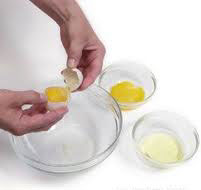 2. Use the 3-bowl method for separating (as recommended by America's Test Kitchen experts): Open cracked eggs over the first bowl and let the whites fall in. Drop yolks into the second bowl. Pour each white into a third "holding" bowl.
2. Use the 3-bowl method for separating (as recommended by America's Test Kitchen experts): Open cracked eggs over the first bowl and let the whites fall in. Drop yolks into the second bowl. Pour each white into a third "holding" bowl.
Why go to all this trouble? Because you can easily separate your first egg or eggs successfully and then on the last egg, whoops - a little yolk just happens to fall in and then contaminates all the whites. The 3-bowl method keeps any possible contamination to a bare minimum - it's better to contaminate just one egg than several.
3. Fix any mistakes. Stray yolks can end up in whites. When this happens, use a shell fragment, and not a spoon, to remove it. The shell membrane is coated with the protein keratin, which attracts the protein in the yolks. If you use a metal spoon, the yolk will scoot out of your grasp, as the yolk contains water and lipoproteins that don't like metal.
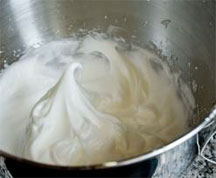 4. Whip whites in a clean, dry bowl (preferably stainless steel or copper, as plastic is porous and can retain traces of fat, while glass and ceramic bowls are slippery so it's harder for whipped whites to billow up).
4. Whip whites in a clean, dry bowl (preferably stainless steel or copper, as plastic is porous and can retain traces of fat, while glass and ceramic bowls are slippery so it's harder for whipped whites to billow up).
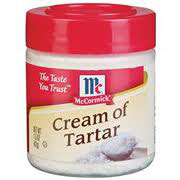 5. Remember 2 things: 1) Fat is the enemy. Fat of any kind (egg yolk, oil, butter, etc.) prevents egg whites from whipping. 2) Cream of tartar is a friend. It's sold in the spice aisle. It's a white powder that is a dry acid. Acids help egg whites whip to a larger and more stable volume. Cream of tartar keeps indefinitely at room temperature.
5. Remember 2 things: 1) Fat is the enemy. Fat of any kind (egg yolk, oil, butter, etc.) prevents egg whites from whipping. 2) Cream of tartar is a friend. It's sold in the spice aisle. It's a white powder that is a dry acid. Acids help egg whites whip to a larger and more stable volume. Cream of tartar keeps indefinitely at room temperature.
6. Know your peak differences:
SOFT:

STIFF:
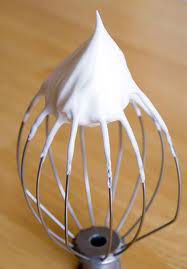
OVERBEATEN:
